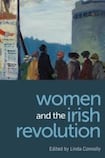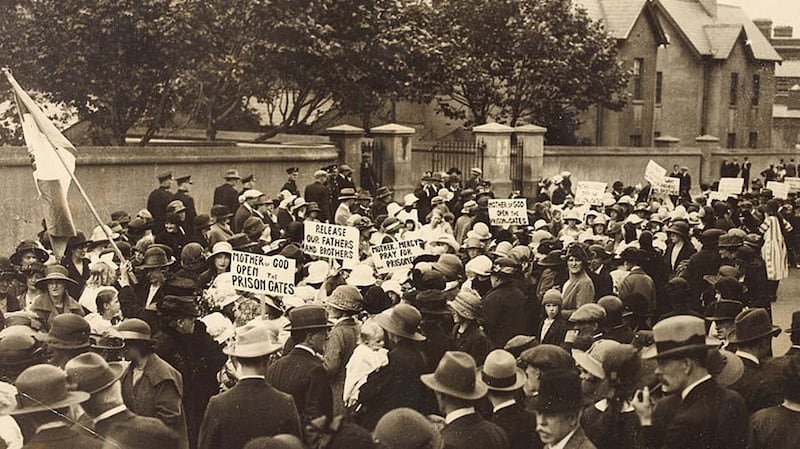
The horrific gang rape of Protestant woman Eileen Biggs in Dromineer, Tipperary in June 1922 is believed to have been carried out by four young local anti-Treaty IRA men. Bigg’s mental and physical health never recovered; she died in St Patrick’s psychiatric hospital in 1950 and is buried in an unmarked grave in Mount Jerome Cemetery.
As explained by Marie Coleman in this book, the archive of the Irish Grants Committee, established by the British government in 1923 to make financial restitution to southern loyalists and which awarded £6,000 to Eileen and her husband, Samuel, provides further detail on the after-effects of the rape. The couple abandoned their home and livelihood in Ireland and the stigma associated with the attack also appears to have led to the suicide of Eileen’s sister Margaret, in her Dublin home in 1924.
The case is a reminder of the valuable light shed by archival material released in recent years on some of those victimised during the revolution; other archives, including the military service pension applications give us numerous insights into the experiences of men and women who fought or assisted in the fighting during the War of Independence and Civil War and how they lived with various legacies. This book makes extensive use of this material and other sources to build on the work that has been done to date on the experiences of Irish women during this period of upheaval.
That body of work is considerable but does not appear to be acknowledged by those publicising this book; an accompanying press release insists that “the narrative of the Irish revolution as a chronology of great men and male militarism, with women presumed to have played a subsidiary role requires urgent reconsideration”. That seems to me a lazy and time-warped assertion and does scant justice to those who have been writing about womens’ involvement in the revolution for many years. As another contributor, Mary McAuliffe, reminds us, “the last four decades have seen an upsurge in interest in and research and writing on women’s experience and involvement in the revolutionary decade”.
The great range of sources cited in this book is an obvious reminder of that, but the introduction by the editor, Linda Connolly, suggests otherwise. What should be a celebration of the vitality of the research and writing on Irish women’s history appears more of a lament for its supposed absence. Connolly asserts that “any claim that Irish women’s role and experience in the revolution is not fully integrated into the established canon because the scholarship does not exist is… inaccurate and unduly serves to airbrush the existing framework”.
But who is making that claim? We are not told, and paradoxically, the next sentence declares that “a prodigious body of work on women and the Irish revolution has existed for a number of decades”. The contention that “the masculinist, militaristic framework at the heart of Irish historiography should be transformed” is therefore very dated; it has long been transformed.
Uneasy companions
Connolly also concludes that “the story of women is the story of the revolution in equal measure”. The meaning of this is not explained, but it needs to be: are we to contrive an ahistorical narrative that ignores the imbalances of a century ago?
Consider fatalities, for example; Andy Bielenberg points out in his essay that as registered homicides mounted during the War of Independence, the female share was 6 per cent in 1920 and 5 per cent in 1921, figures that “starkly” reveal a “dramatic gender imbalance during the conflict”.
Women were at loggerheads at various stages during the revolution. As elucidated by Louise Ryan, suffrage newspaper the Irish Citizen described Cumann na mBan, the female auxiliary of the IRA, as “thoroughly reactionary” in 1914 for what it regarded as its downgrading of the suffragette cause.
There was, notes Ryan, a “tricky path between demanding women’s rights and risking the antagonism of groups demanding the nation’s right to self-determination”. But the Irish Citizen also broke barriers with its discussions of child abuse, incest, rape and marital violence. One of its contributors, Margaret Connery, demanded the “ventilation of evils” in Irish society, decrying that for some “the length of women’s skirts” seemed more morally urgent that “the length of the European war”.
In Holloway prison, Kathleen Clarke, Maud Gonne and Constance Markievicz were sometimes uneasy companions. Lucy McDiarmid’s brilliant dissection of this triangle highlights sisterhood but also class and social tensions as Clarke found herself a “buffer state” between two great snobs: “Madame Markievicz took pains to make me aware of the social gulf between us.” Clarke fiercely defended her authority over her cell as Markievicz covered it in cigarette ash – “get out, stay out” she told her.

Margaret Ward, a pioneer of women’s history from the early 1980s onwards, looks at women active in Cumann na mBan in Belfast and their later battles for military service pensions as “a strict demarcation between the less regarded work of Cumann na mBan and that of providing military support for the IRA informed the attitude of pension assessors”. Dangerous work such as transferring rifles was summarily dismissed as “routine work” and “to succeed in obtaining a pension they had to prove that they had transgressed gender norms”.
Marie Coleman also elaborates on this theme; there were five grades of pension, A-E, but women were confined to the two lower grades of D and E on the grounds that, in the words of minister for defence Frank Aiken in 1934, “their responsibilities were not as great” as those of the IRA. Other women faced disappointing decisions from the IGC. One was Agnes O’Halloran, a widow who resisted threats to stop her work as a washer-woman for the Royal Irish Constabulary in Ennistymon but became unemployed on the disbandment of the force.
As John Borgonovo highlights, Cumann na mBan “undertook most of the republican propaganda responsibilities” during the Civil War, when they also “assumed more overtly military and thus less gendered duties”. At least 560 of them were incarcerated, compared with about 50 during the War of Independence. The six female Sinn Féin TDs in 1921 spoke against the Treaty. With that, observes Claire McGing, the contention that women were “too inflexible, bitter and emotional for politics” took hold; they were “practically unsexed” declared PS O’Hegarty. Only three women were elected TDs in June 1927.
Home as battleground
Mary McAuliffe reflects on the domestic space; many Cumann na mBan members were working from their homes, meaning that for some “their homes were, most often, their battlegrounds”. Their activities also impacted greatly on female relatives. Mary O’Neill of the Mid-Clare Cumman na mBan pointed out that her mother was “a physical and mental wreck after the house was looted and burned”.
Some of those who were deemed to have transgressed were sexually assaulted and publicly humiliated: “You won’t be seen going to the Creamery for a while” a young woman who was keeping company with policemen was told in July 1920 after her hair was cut off, just one manifestation of the physical brutalities inflicted on some women.
Ailbhe McDaid focuses on how the work of renowned poets Paula Meehan, Éiléan Ní Chuilleanáin and Martina Evans meditates on silences about women and the power dynamic between authorised and subversive narratives. Meehan’s Them Ducks Died for Ireland includes the lines:
"We'll salute the stretcher-bearer, the nurse in white,
the ones who pick up the pieces, who endure,
who live at the edge, and die there and are known
by this archival footnote read by fading light"
Sarah-Ann Buckley and John Cunningham cleverly turn the spotlight on the Tuam mother and baby home by recalling a morning in April 1932 when 20 members of the IRA were greeted at the old workhouse building by Sr Hortense of the Bon Secours congregation, which had taken over the site in 1925.
In April 1923, towards the end of the Civil War, six IRA men had been executed in the workhouse by Free State forces and, as was apparent in 1932, the Bon Secours sisters ensured those dead were reverentially remembered; Sr Hortense gave permission for a small monument on the site of the executions “bearing the names of the dead heroes”.
This, of course, raises “provocative questions about selective remembrance”; Sr Hortense had the site blessed and placed a wooden crucifix there and “prayers were offered continually by the community and mass celebrated annually on the site”. An additional monument was erected to the memory of the IRA men in 1985, but it was to be another 30 years before a small monument to the children who died in the home was placed on the wall of theinstitution.
Reverence for the dead, as with the historical narrative more generally, can be cruelly selective. This book highlights multiple female experiences, the original and vital insights provided by those who have been researching women’s history for decades, and the continuing efforts to broaden and complicate the narrative of the Irish revolutionary decade.
Diarmaid Ferriter is professor of modern Irish history at UCD. His book Between Two Hells: The Irish Civil War will be published by Profile Books in September.










